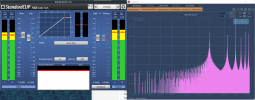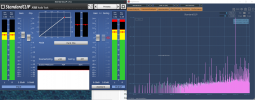Three takes are modelers, one is the real amp:
https://www.fractalaudio.com/tmp/Be_Be_Be.mp3
Deluxe Reverb Vibrato channel
Gain 10
Bass 2
Treble 8
I am going to give this my very best effort -- fail or not.
The most noticeable quality, to me, was the the sustain of the overtone series.
Both #3 and #4 were very unsatisfying to me.
In both #3 and #4, the harmonics faded out much too soon,
much too abruptly, and much too unevenly.
#1 and #2 were both much more satisfying to me
-- as a result of the sustained harmonics and overtones.
Regarding #1 and #2, I found:
1) Both #1 and #2 and a longer sustain of the harmonic comb.
2) And, both #1 and #2 had a pleasing dynamic change in the overtones
as the overtones continued to sustain
3) #2 had the longest sustain of the harmonic overtone series.
4) As a result, #2 had a greater amount of harmonics (hair)
-- while maintaining the same level, or peak, of distortion as #1.
5) #2 also had a more complex morphing of the overtone series than #1.
Some cork-sniffers have referred to this quality as "swirl."
That is a good metaphoric term to me.
6) However, there is another quality difference between #1 and #2.
7) My best description of this difference
is the the difference between a vintage pulsonic-coned greenback
and a more modern vintage 30 greenback
This is a very exaggerated comparison.
The audible difference between #1 and #2 is only similar.
The actual difference between #1 and #2 is much, much smaller.
8) The pulsonic/V30 tonal difference is one of both smoothness and attitude.
Unfortunately, b****yness (V30)is the most descriptive term
-- although, hugely overstated.
9) My unfounded speculation is that this is how I hear aliasing.
I am not sure about that.
However, a V30's peakiness in the 2-3K range
gives it a more forward-sounding, more in-your-face, attitude.
10) So, I wonder if there is a fine, subtle peakiness, that I might hearing.
Perhaps, a quality caused by peaking due to aliasing sidebands?
11) Points #9 and #10 are hugely speculative
-- and very possibly a false hypothesis.
12) Specifically, #1 approached the smoother "pulsonic" sound.
#2 approached the more forward "V30" sound.
13) Both #1 and #2 sounded vocal and expressive to me.
#2 sounded very slightly more vocal and expressive to me.
14) I also find #2 to have a more defined, more chiseled,
more outlined sound. Which I actually like.
In fact, in other comparisons,
I have chosen Fractal model recordings over real amps
because they had a more precise, more defined sound.
So these are my guesses:
#1 is the real amp
#2 is the Fractal model -- due to:
longer harmonic sustain
more dynamically complex harmonic shifts in the sustain
a slightly more forward attitude in the tone
a more defined, more chiseled, more outlined tone
#3 and #4 did not please me.
#2 is my personal favorite.
I do like #1, also.
I sincerely hope I have not embarressed myself.
Flame Away My Tonal Frenemies!
 ) to provide some education on this subject.
) to provide some education on this subject. ) to provide some education on this subject.
) to provide some education on this subject.






